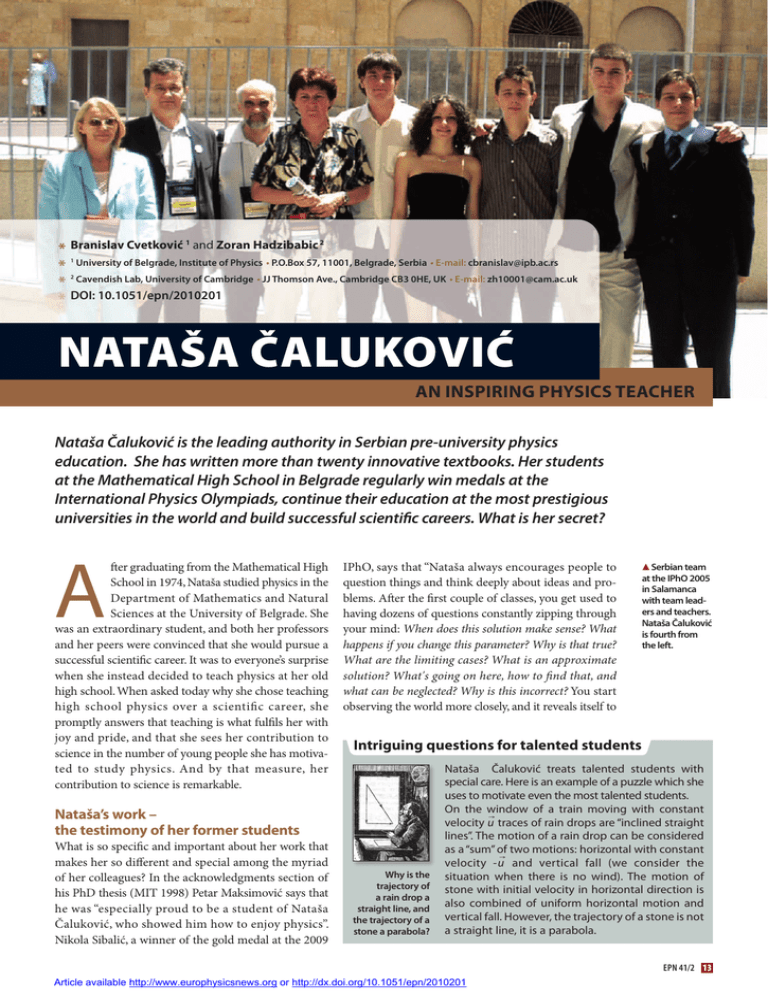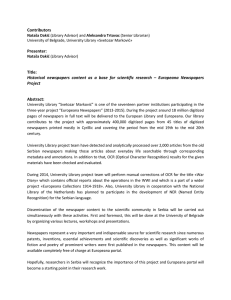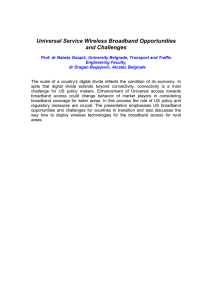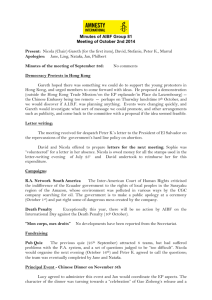Nataša Čaluković, an inspiring physics teacher
advertisement

1 2 * Branislav Cvetković and Zoran Hadzibabic * University of Belgrade, Institute of Physics • P.O.Box 57, 11001, Belgrade, Serbia • E-mail: cbranislav@ipb.ac.rs * Cavendish Lab, University of Cambridge • JJ Thomson Ave., Cambridge CB3 0HE, UK • E-mail: zh10001@cam.ac.uk * DOI: 10.1051/epn/2010201 1 2 Nataša Čaluković An InSPIrInG PHySICS TEACHEr Nataša Čaluković is the leading authority in Serbian pre-university physics education. She has written more than twenty innovative textbooks. Her students at the Mathematical High School in Belgrade regularly win medals at the International Physics Olympiads, continue their education at the most prestigious universities in the world and build successful scientific careers. What is her secret? A er graduating from the Mathematical High School in 1974, Nataša studied physics in the Department of Mathematics and Natural Sciences at the University of Belgrade. She was an extraordinary student, and both her professors and her peers were convinced that she would pursue a successful scientific career. It was to everyone’s surprise when she instead decided to teach physics at her old high school. When asked today why she chose teaching high school physics over a scientific career, she promptly answers that teaching is what fulfils her with joy and pride, and that she sees her contribution to science in the number of young people she has motivated to study physics. And by that measure, her contribution to science is remarkable. IPhO, says that “Nataša always encourages people to question things and think deeply about ideas and problems. Aer the first couple of classes, you get used to having dozens of questions constantly zipping through your mind: When does this solution make sense? What happens if you change this parameter? Why is that true? What are the limiting cases? What is an approximate solution? What's going on here, how to find that, and what can be neglected? Why is this incorrect? You start observing the world more closely, and it reveals itself to Intriguing questions for talented students nataša’s work – the testimony of her former students What is so specific and important about her work that makes her so different and special among the myriad of her colleagues? In the acknowledgments section of his PhD thesis (MIT 1998) Petar Maksimović says that he was “especially proud to be a student of Nataša Čaluković, who showed him how to enjoy physics”. Nikola Sibalić, a winner of the gold medal at the 2009 䉱 Serbian team at the IPhO 2005 in Salamanca with team leaders and teachers. Nataša Čaluković is fourth from the left. Why is the trajectory of a rain drop a straight line, and the trajectory of a stone a parabola? Nataša Čaluković treats talented students with special care. Here is an example of a puzzle which she uses to motivate even the most talented students. On the window of a train moving with constant → velocity u traces of rain drops are “inclined straight lines”. The motion of a rain drop can be considered as a “sum” of two motions: horizontal with constant → velocity -u and vertical fall (we consider the situation when there is no wind). The motion of stone with initial velocity in horizontal direction is also combined of uniform horizontal motion and vertical fall. However, the trajectory of a stone is not a straight line, it is a parabola. EPN 41/2 13 Article available http://www.europhysicsnews.org or http://dx.doi.org/10.1051/epn/2010201 feaTureS an inSPiring PHySiCS TeaCHer you in its full splendor and diversity. Her approach to physics is really a mind-opening experience”. Nataša is deeply aware that physics cannot be learnt just from books, and that creating new science relies on a dynamic interplay of discussions, calculations and experiments, and requires many trials and errors. All this takes place in Nataša’s lectures, and rather than being taught as a matter of fact, physics is being rediscovered by high school students in a small lecture hall. at is really a unique experience, and it is hard to forget the pleasant and stimulating atmosphere of her classes. She always encouraged us to work together and explain ideas to each other, question the physical meaning of the mathematical solutions, and think of gedanken experiments. e training in rigorous problem solving is a traditional strength of the Mathematical High School, but one of Nataša’s specialties are tests consisting of conceptual questions which can be deceptively simple but are oen far more profound than the formally more difficult mathematical problems. She has taught us the difference between knowing and understanding, and that asking a question is oen more difficult and important than answering one. In her own way, for the past few decades she has been developing ideas about high school physics education which parallel the modern world trends in improving physics teaching at the university level, and many of her methods are akin to those championed by Dave Pritchard at MIT or Eric Mazur at Harvard. nataša’s work from her own prospective According to Nataša,everything she teaches first has to be crystal clear to her personally, before she can adapt and transfer the knowledge to the students at the level which is acceptable and understandable to them. is requires constant learning, thinking, and research. She never relies on a single textbook for her courses, even if she wrote it herself, and she always tries to refresh her lectures with new and innovative examples. She says that the Russian Facts and figures Nataša Čaluković is an exceptional educator. Since 1986, 26 of her students made 36 appearances at the International Physics Olympiads and Junior Science Olympiads. They were honoured by two gold, nine silver, and twelve bronze medals, as well as ten honourable mentions. During her carrier she motivated more than 65 of her pupils to choose the career of a physicist. Her former students are now researchers or faculty members at several Institutes and Universities in Belgrade (>10), in Austria, UK, USA, The Netherlands and Germany. The Mathematical High School is by far the most respected secondary school in Serbia and one of the best educational institutions in the region. In the forty four year long history of the school its students have won more than 300 medals at the International Mathematical, Physics, Computer Science and Astronomy Olympiads. The school has long standing collaborations with similar institutions worldwide as well as with higher education establishments in Belgrade. 14 EPN 41/2 “Quantum” has been one of the most reliable sources of intriguing problems.She is also quick to modestly say that she owes a significant part of her knowledge to her students; she sees every clever question they raise as a sign that her explanations are incomplete, still not sufficiently clear, or maybe even wrong. Nataša is encouraging and inspiring to all her students, and values both their intellectual abilities and their efforts to learn and to perform experiments. She examines students through longer written exams (four times a year), shorter multiple-choice tests, and oral exams. e written exams test students’ ability to apply physical laws to solving problems of various levels of mathematical difficulty. Choosing the correct answers on the multiple-choice tests requires quick thinking and internalization of the key formulae and physical concepts such as conservation laws.In oral exams students show the ability to clearly present and explain topics from the curriculum. In assigning grades, Nataša appreciates students’ imagination, creativity and independent work. Participation and success in the national and international competitions, good seminar papers, raising good questions in class, and spotting nontrivial mistakes in her lectures or other students’ answers also contribute to the final grade. Chuck norris is afraid of nataša Čaluković Nataša is not only an excellent teacher, but also an amazing person, and is held in highest regard both by her students and by other physics teachers in Serbia. Her colleagues admire her success with students and like to use the textbooks she wrote. Many ask her to sign their copies of her books. From her side, she greatly appreciates the collaboration with her colleague Jovica Milosavljević because of his efforts to build and maintain an excellent Physics laboratory in their school. Her great authority among the students relies on her knowledge and years of experience, but also on the fact that she treats all students equally and expects them to learn a lot. She is intellectually extremely strict,but always fair.As the saying among the current students of the Mathematical High School goes, Chuck Norris is afraid of Nataša Čaluković. To a lesser teacher that would have been enough of an accomplishment, but she keeps striving for more. ■ About the authors Branislav Cvetković was educated at the Mathematical High School in Belgrade and the University of Belgrade. He is an Assistant Research Professor at the Institute of Physics in Belgrade, and also teaches at the Mathematical High School. Zoran Hadzibabic was educated at the Mathematical High School in Belgrade, University of Cambridge, and MIT. He is a University Lecturer in the Department of Physics and Fellow of Trinity College at the University of Cambridge.


